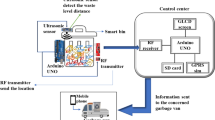Abstract
Network resources in mobile ad hoc wireless networks (MANETs) are constrained due to their dynamic topology and lack of centralized control. Mobile nodes in MANETs tend to broadcast packets to exchange information and consume lots of network resources such as network bandwidth and battery power of each node during forwarding their packets. Hence, the conserving network resource is crucial to maintain the quality of network services without interruptions. In order to discover an ideal routing algorithm that should use minimum network resources and improve network performance, we propose an adaptive-gossiping routing algorithm that saves network bandwidth and energy consumption at each node by reducing the duplicated routing messages. Our new analytical model of adaptive-gossiping probability \(p_{n}\) provides a less routing overhead which results in conserving network resources and reducing the end-to-end delay. The both analytical and experimental results of our proposed method confirm its advantages over flooding and static-gossiping based routing protocols in large-scale networks.










Similar content being viewed by others
References
Bettstetter, C., & Eberspacher, J. (2003). Hop distances in homogeneous ad hoc networks. In Proceedings of (ICON’03) (pp. 603–609).
Chandra, R., Ramasubramanian, V., & Birman, K. P. (2001). Anonymous gossip: Improving multicast reliability in mobile ad hoc networks. In Proceedings of ( ICDCS’01) (pp. 275–283).
Chen, S., & Nahrstedt, K. (1999). Distributed quality-of-service routing in ad hoc networks. IEEE Journal on Selected Areas in Communications, 17(8), 1488–1505.
Chen, L., & Heinzelman, W. B. (2007). A survey of routing protocols that support QoS in mobile ad hoc networks. IEEE Network, 21(6), 30–38.
Corson, S., & Macker, J. (1999). Mobile ad hoc networking (MANET): Routing protocol performance issues and evaluating considerations. RFC Editor.
Corson, S., & Macker, J. (1999). Mobile ad hoc networking (MANET): Routing protocol performance issues and evaluating considerations. RFC Editor.
Eugster, P. T., Guerraoui, R., Handurukande, S. B., Kouznetsov, P., & Kermarrec, A.-M. (2003). Lightweight probabilistic broadcast. ACM Transactions on Computer Systems, 21(4), 341–374.
Guan, X., Guan, L., Wang, X. G., & Ohtsuki, T. (2010). A new load balancing and data collection algorithm for energy saving in wireless sensor networks. Telecommunication Systems, 45, 313–322.
Hass, Z., Halpern, J. Y., & Li, L. (2006). Gossip-based ad hoc routing. IEEE/ACM Transaction on Networking, 14(3), 479–491.
Heinzelman, W., Kulik, J., & Balakrishnan, H. (1999). Adaptive protocols for information dissemination in wireless sesor networks. In Proceedings of (MobiCom’99) (pp. 174–185).
IEEE standard for Wireless LAN Medium Access Control (MAC) and Physical Layer (PHY) specifications, IEEE Std: 802.11b-1999/Cor 1–2001 (2001).
Kermarrec, A.-M., & Steen, M. V. (2007). Gossiping in distributed systems. ACM Operating System Review, 41(5), 2–7.
Lee, A., & Ra, I. (2010). Adaptive-gossiping for an energy-aware routing protocol in wireless sensor networks. In Proceedings of (IWCMC’10) (pp. 1131–1135).
Lee, A., Ra, I., & Kim, H. (2009). Performance study of ad hoc routing protocols with gossip-based approach. In Proceedings of (CNS’09).
Lee, A., Ra, I., & Kim, H. S. (2009). Performance study of ad hoc routing protocols with gossip-based approach. In Proceedings of (ACM SpringSim, CNS 2009) (p. 89).
Marinoni, S., & Kari, H. H. (2006). Ad hoc routing protocol’s performance: A realistic simulation based study. Telecommunication Systems, 33, 269–289.
Miller, M., Sengul, C., & Gupta, I. (2005). Exploring the energy-latency tradeoff for broadcasts in energy-saving sensor networks. In Proceedings of ( ICDCS’05) (pp. 17–26).
Penrose, M. (2003). Random geometric graphs. Oxford: Oxford University Press.
Perkins, C. E., & Royer, E. M. (1999). Ad hoc on-demand distance vector routing. In Proceedings of ( WMCSA’99) (pp. 90–100).
Royer, E. M., & Toh, C. K. (1999). A review of current routing protocols for ad hoc mobile wireless networks. IEEE Personal Communications Magazine, 6(2), 46–55.
The Network Simulator, “NS-2.” Available: http://www.isi.edu/nsnam/ns/
Zhang, N., & Anpalagan, A. (2009). Sensitivity of SWAN QoS model in MANETs with proactive and reactive routing: A simulation study. Telecommunication Systems, 44, 17–27.
Acknowledgments
The authors would like to thank Anatolii A. Puhalskii, an associate professor in Mathematical and Statistical Sciences at the University of Colorado Denver, for explaining the relevant analysis of adaptive-gossiping routing algorithm.
Author information
Authors and Affiliations
Corresponding author
Rights and permissions
About this article
Cite this article
Lee, A., Ra, I. Network resource efficient routing in mobile ad hoc wireless networks. Telecommun Syst 60, 215–223 (2015). https://doi.org/10.1007/s11235-015-0024-7
Published:
Issue Date:
DOI: https://doi.org/10.1007/s11235-015-0024-7




